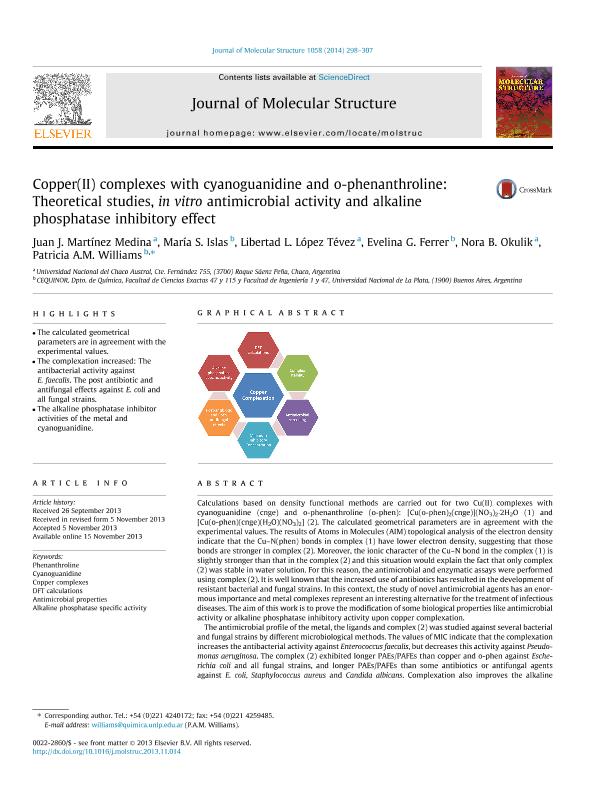Artículo
Copper(II) complexes with cyanoguanidine and o-phenanthroline: Theoretical studies, in vitro antimicrobial activity and alkaline phosphatase inhibitory effect
Martínez Medina, Juan José ; Islas, María Soledad
; Islas, María Soledad ; López Tévez, Libertad Leonor; Ferrer, Evelina Gloria
; López Tévez, Libertad Leonor; Ferrer, Evelina Gloria ; Okulik, Nora Beatriz
; Okulik, Nora Beatriz ; Williams, Patricia Ana María
; Williams, Patricia Ana María
 ; Islas, María Soledad
; Islas, María Soledad ; López Tévez, Libertad Leonor; Ferrer, Evelina Gloria
; López Tévez, Libertad Leonor; Ferrer, Evelina Gloria ; Okulik, Nora Beatriz
; Okulik, Nora Beatriz ; Williams, Patricia Ana María
; Williams, Patricia Ana María
Fecha de publicación:
01/2014
Editorial:
Elsevier Science
Revista:
Journal of Molecular Structure
ISSN:
0022-2860
Idioma:
Inglés
Tipo de recurso:
Artículo publicado
Clasificación temática:
Resumen
Calculations based on density functional methods are carried out for two Cu(II) complexes with cyanoguanidine (cnge) and o-phenanthroline (o-phen): [Cu(o-phen)2(cnge)](NO3)22H2O (1) and [Cu(o-phen)(cnge)(H2O)(NO3)2] (2). The calculated geometrical parameters are in agreement with the experimental values. The results of Atoms in Molecules (AIM) topological analysis of the electron density indicate that the Cu–N(phen) bonds in complex (1) have lower electron density, suggesting that those bonds are stronger in complex (2). Moreover, the ionic character of the Cu–N bond in the complex (1) is slightly stronger than that in the complex (2) and this situation would explain the fact that only complex (2) was stable in water solution. For this reason, the antimicrobial and enzymatic assays were performed using complex (2). It is well known that the increased use of antibiotics has resulted in the development of resistant bacterial and fungal strains. In this context, the study of novel antimicrobial agents has an enormous importance and metal complexes represent an interesting alternative for the treatment of infectious diseases. The aim of this work is to prove the modification of some biological properties like antimicrobial activity or alkaline phosphatase inhibitory activity upon copper complexation. The antimicrobial profile of the metal, the ligands and complex (2) was studied against several bacterial and fungal strains by different microbiological methods. The values of MIC indicate that the complexation increases the antibacterial activity against Enterococcus faecalis, but decreases this activity against Pseudomonas aeruginosa. The complex (2) exhibited longer PAEs/PAFEs than copper and o-phen against Escherichia coli and all fungal strains, and longer PAEs/PAFEs than some antibiotics or antifungal agents against E. coli, Staphylococcus aureus and Candida albicans. Complexation also improves the alkaline phosphatase inhibitory effect of copper and cnge. Therefore, the interaction of copper(II) with N-containing ligands may provide a promising strategy for the development of novel drugs with enhanced antimicrobial activity or alkaline phosphatase inhibitory activity.
Archivos asociados
Licencia
Identificadores
Colecciones
Articulos(CEQUINOR)
Articulos de CENTRO DE QUIMICA INORGANICA "DR. PEDRO J. AYMONINO"
Articulos de CENTRO DE QUIMICA INORGANICA "DR. PEDRO J. AYMONINO"
Citación
Martínez Medina, Juan José; Islas, María Soledad; López Tévez, Libertad Leonor; Ferrer, Evelina Gloria; Okulik, Nora Beatriz; et al.; Copper(II) complexes with cyanoguanidine and o-phenanthroline: Theoretical studies, in vitro antimicrobial activity and alkaline phosphatase inhibitory effect; Elsevier Science; Journal of Molecular Structure; 1058; 1-2014; 298-307
Compartir
Altmétricas



